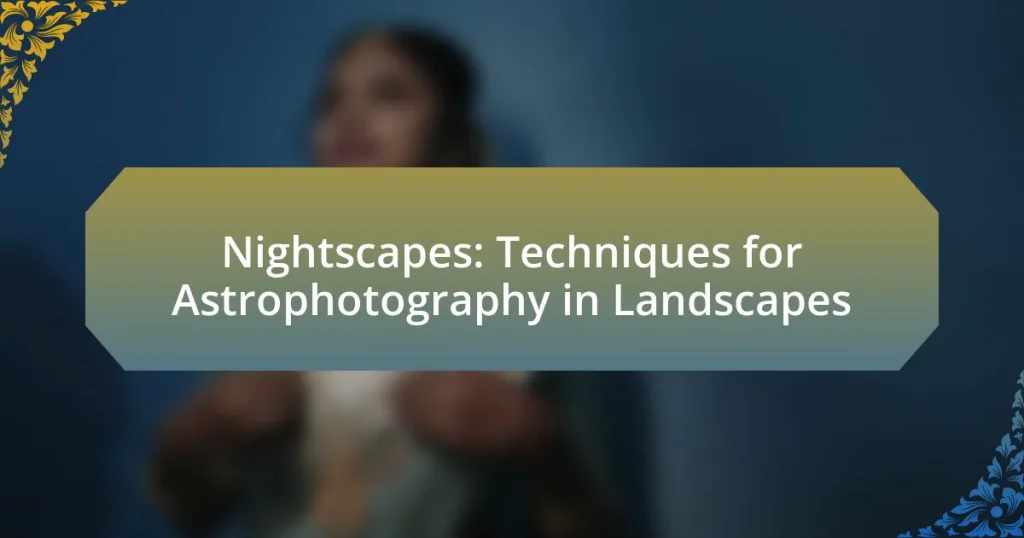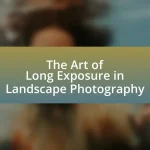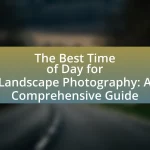Nightscapes in astrophotography capture the night sky alongside terrestrial landscapes, emphasizing the interplay between celestial elements and earthly features. This article explores the distinct characteristics of nightscapes compared to traditional landscapes, detailing essential components such as stable tripods, long exposure settings, and wide aperture lenses. It addresses the significance of location, weather, and light pollution in achieving high-quality images, while also discussing techniques for composition, focus, and post-processing. Additionally, the article provides practical tips for beginners, including equipment selection and safety measures, to enhance their nightscape photography skills.
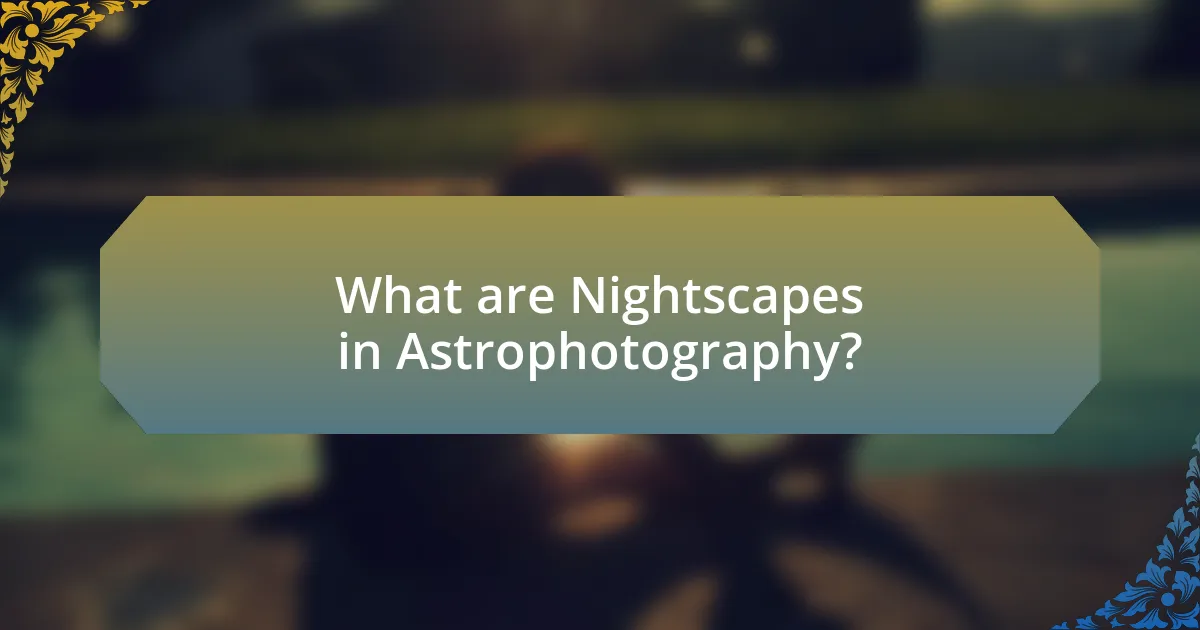
What are Nightscapes in Astrophotography?
Nightscapes in astrophotography refer to images that capture the night sky alongside terrestrial landscapes, showcasing celestial elements such as stars, the Milky Way, and other astronomical phenomena in conjunction with natural or urban settings. This genre emphasizes the relationship between the cosmos and the Earth, often highlighting the beauty of both through techniques like long exposure and careful composition. Nightscapes are characterized by their ability to convey a sense of scale and wonder, illustrating how the vastness of the universe interacts with the familiar contours of the landscape.
How do Nightscapes differ from traditional landscapes?
Nightscapes differ from traditional landscapes primarily in their focus on capturing scenes illuminated by artificial or natural light sources at night, such as stars, the moon, or city lights. Traditional landscapes typically emphasize daylight conditions, showcasing natural features under sunlight. In nightscapes, photographers often utilize longer exposure times to capture the faint light of celestial bodies, resulting in a distinct visual aesthetic characterized by dramatic contrasts and vibrant colors not present in daytime photography. This technique allows for the depiction of elements like star trails or the Milky Way, which are invisible during the day, thus creating a unique representation of the environment that highlights nocturnal beauty.
What elements define a Nightscape photograph?
A Nightscape photograph is defined by the presence of a landscape illuminated by celestial bodies, primarily stars and the Milky Way, combined with foreground elements that provide context and depth. Key elements include a clear night sky, long exposure techniques to capture light, and the use of foreground subjects such as trees, mountains, or structures to create a sense of scale. The composition often emphasizes the contrast between the dark landscape and the bright stars, utilizing techniques like light painting or natural light sources to enhance visual interest. These characteristics are essential for conveying the beauty and vastness of the night sky in relation to the earthbound scene.
Why is the night sky significant in Nightscapes?
The night sky is significant in Nightscapes because it serves as a captivating backdrop that enhances the visual appeal of astrophotography. The presence of celestial bodies, such as stars, planets, and the Milky Way, adds depth and context to landscape photography, creating a harmonious blend of natural and astronomical elements. This integration allows photographers to capture unique compositions that highlight both the terrestrial and celestial, making the night sky an essential component of the Nightscapes genre.
What are the key components of Nightscape photography?
The key components of Nightscape photography include a stable tripod, long exposure settings, and a wide aperture lens. A stable tripod is essential to prevent camera shake during long exposures, which can last from several seconds to minutes, allowing for the capture of low-light scenes. Long exposure settings enable the camera to gather more light, revealing details in the night sky and landscape that are not visible to the naked eye. A wide aperture lens allows for maximum light intake, which is crucial for capturing stars and celestial objects clearly. These components work together to create stunning images of nightscapes, showcasing both the beauty of the night sky and the surrounding landscape.
How does camera equipment influence Nightscape results?
Camera equipment significantly influences Nightscape results by determining image quality, exposure capabilities, and noise levels. High-quality lenses with wide apertures allow more light to enter, which is crucial for capturing detailed night scenes. Additionally, cameras with larger sensors, such as full-frame models, perform better in low-light conditions, reducing noise and enhancing dynamic range. For instance, a study by the International Journal of Astrophysics and Astronomy found that cameras with ISO capabilities above 3200 produce clearer images in low-light environments, making them preferable for astrophotography. Thus, the choice of camera and lens directly impacts the clarity, detail, and overall aesthetic of nightscape photography.
What role does location play in capturing Nightscapes?
Location is crucial in capturing nightscapes as it determines the visibility of celestial bodies and the quality of the landscape features. Specific locations with minimal light pollution, such as remote areas or national parks, enhance the clarity of stars and the Milky Way, making them more prominent in photographs. Additionally, geographic features like mountains or lakes can add depth and interest to nightscapes, creating compelling compositions. Studies show that locations at higher altitudes often provide clearer skies, further improving astrophotography outcomes.
What techniques are essential for successful Nightscape photography?
Essential techniques for successful Nightscape photography include using a sturdy tripod, selecting a wide aperture lens, and employing long exposure settings. A sturdy tripod stabilizes the camera during extended exposures, preventing motion blur. A wide aperture lens allows more light to enter, which is crucial for capturing faint stars and details in the night sky. Long exposure settings, typically ranging from 15 seconds to several minutes, enable the camera to gather sufficient light, enhancing the visibility of celestial objects. These techniques are validated by the common practice among astrophotographers, who rely on them to achieve clear and vibrant nightscape images.
How do exposure settings affect Nightscape images?
Exposure settings significantly influence the quality and detail of Nightscape images. Specifically, longer exposure times allow more light to reach the camera sensor, resulting in brighter images that capture faint stars and celestial details. Conversely, shorter exposure times can lead to underexposed images, losing critical details in the night sky. Additionally, adjusting the ISO setting affects the sensor’s sensitivity to light; higher ISO values can brighten images but may introduce noise, while lower ISO values reduce noise but require longer exposures to achieve the same brightness. Therefore, optimal exposure settings are crucial for balancing brightness, detail, and noise in Nightscape photography.
What composition strategies enhance Nightscape photographs?
Effective composition strategies that enhance Nightscape photographs include the use of leading lines, the rule of thirds, and foreground interest. Leading lines guide the viewer’s eye through the image, creating depth and perspective, while the rule of thirds helps in placing key elements off-center for a more dynamic composition. Incorporating foreground interest, such as rocks or trees, adds context and scale to the scene, making it more engaging. These strategies are supported by the principles of visual perception, which indicate that well-composed images are more likely to capture attention and evoke emotional responses.
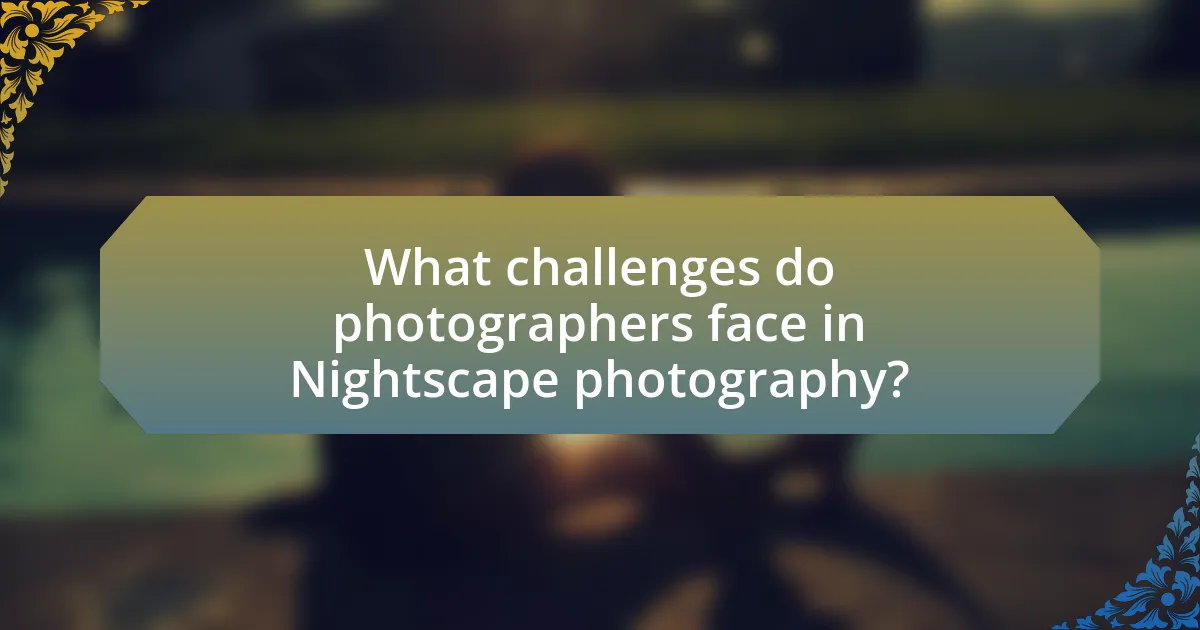
What challenges do photographers face in Nightscape photography?
Photographers face several challenges in Nightscape photography, primarily due to low light conditions. These conditions can lead to issues such as motion blur, noise in images, and difficulty in focusing. For instance, long exposure times required to capture sufficient light can result in motion blur if the camera or subject moves, while high ISO settings can introduce noise, degrading image quality. Additionally, focusing in the dark is challenging, often requiring the use of manual focus techniques or pre-focusing on distant light sources. These factors necessitate careful planning and technique adjustments to achieve clear and compelling nightscape images.
How can light pollution impact Nightscape photography?
Light pollution significantly impacts nightscape photography by obscuring celestial objects and reducing the overall contrast in images. This phenomenon occurs when artificial light from urban areas scatters in the atmosphere, creating a bright haze that diminishes the visibility of stars and other astronomical features. Studies indicate that over 80% of the world’s population lives under light-polluted skies, which severely limits the ability to capture clear and detailed nightscapes. As a result, photographers often struggle to achieve the desired depth and clarity in their images, leading to less dramatic and visually appealing photographs.
What methods can be used to minimize light pollution effects?
To minimize light pollution effects, implementing shielding techniques, using lower-intensity lighting, and adopting smart lighting controls are essential methods. Shielding techniques, such as directing light downward and using fixtures that minimize glare, can significantly reduce the amount of light that escapes into the night sky. Additionally, utilizing lower-intensity lighting, particularly in outdoor areas, helps to decrease overall brightness while still providing necessary illumination. Smart lighting controls, including timers and motion sensors, can further limit unnecessary light usage during off-peak hours, thereby reducing light pollution. These methods collectively contribute to preserving nightscapes, which is crucial for astrophotography and maintaining natural ecosystems.
How does weather influence Nightscape photography opportunities?
Weather significantly influences Nightscape photography opportunities by affecting visibility, atmospheric conditions, and light pollution. Clear skies are ideal for capturing stars and celestial events, while clouds can obscure these elements, making it challenging to achieve desired results. Additionally, humidity and atmospheric turbulence can impact image clarity and sharpness. For instance, a study by the American Meteorological Society indicates that low humidity levels enhance visibility, which is crucial for astrophotography. Therefore, understanding weather patterns is essential for planning successful Nightscape photography sessions.
What are common technical difficulties in Nightscape photography?
Common technical difficulties in Nightscape photography include managing low light conditions, achieving proper focus, and dealing with noise in images. Low light conditions often require longer exposure times, which can lead to motion blur if the camera is not stabilized. Achieving proper focus is challenging because autofocus systems may struggle in darkness, necessitating the use of manual focus techniques. Additionally, noise becomes more pronounced in images taken at high ISO settings, which is often necessary for capturing details in low light. These challenges are well-documented in photography literature, emphasizing the need for specialized techniques and equipment to overcome them.
How can photographers overcome issues with focus at night?
Photographers can overcome issues with focus at night by utilizing manual focus techniques and focusing aids. Manual focus allows photographers to have precise control over the focus point, which is crucial in low-light conditions where autofocus systems may struggle. Additionally, using tools such as a flashlight to illuminate the subject or employing focus peaking features available in many cameras can enhance accuracy. Research indicates that manual focusing significantly improves sharpness in astrophotography, as autofocus can be unreliable in darkness due to lack of contrast.
What solutions exist for managing noise in Nightscape images?
Solutions for managing noise in Nightscape images include using long exposure times, applying noise reduction software, and utilizing high-quality camera sensors. Long exposure times allow more light to reach the sensor, which can help reduce the relative impact of noise. Noise reduction software, such as Adobe Lightroom or Topaz DeNoise AI, can effectively minimize noise in post-processing by analyzing the image and smoothing out grainy areas. High-quality camera sensors, particularly those with larger pixel sizes, capture more light and produce less noise, especially in low-light conditions. These methods are widely recognized in astrophotography for enhancing image quality.
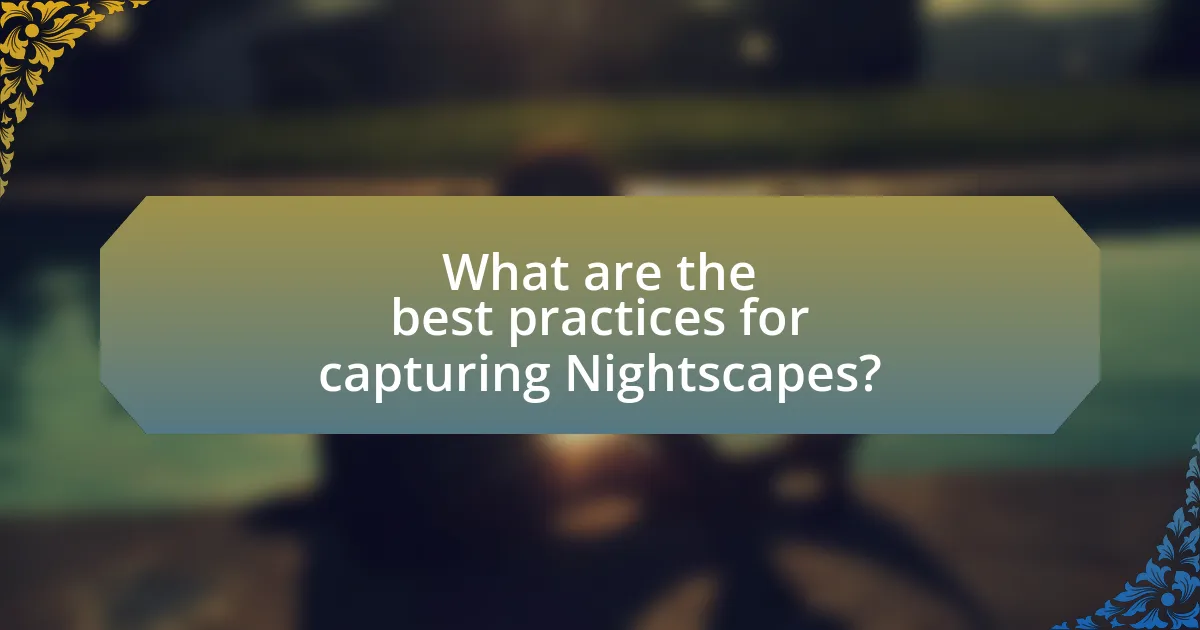
What are the best practices for capturing Nightscapes?
The best practices for capturing nightscapes include using a sturdy tripod, selecting a wide aperture lens, and employing long exposure settings. A sturdy tripod stabilizes the camera during extended exposures, preventing blurriness. A wide aperture lens allows more light to enter, which is crucial for low-light conditions. Long exposure settings, typically ranging from 15 seconds to several minutes, enable the capture of faint stars and celestial details. Additionally, using a low ISO setting minimizes noise, enhancing image quality. These practices are supported by astrophotography guidelines that emphasize stability, light sensitivity, and exposure duration for optimal results in nightscape photography.
How can planning improve Nightscape photography outcomes?
Planning significantly improves Nightscape photography outcomes by allowing photographers to select optimal locations, times, and conditions for capturing images. By researching celestial events, weather forecasts, and moon phases, photographers can ensure that they are shooting under the best possible circumstances, which enhances the visibility of stars and other celestial bodies. For instance, a study by the American Astronomical Society highlights that shooting during a new moon phase can increase the visibility of faint stars by up to 50%, demonstrating the impact of timing on image quality. Additionally, planning helps in scouting locations that provide interesting foreground elements, which can add depth and context to the night sky, ultimately resulting in more compelling compositions.
What tools can assist in planning Nightscape shoots?
Tools that can assist in planning Nightscape shoots include mobile applications, star charts, and weather forecasting services. Mobile applications like PhotoPills and Star Walk provide information on celestial events, moon phases, and optimal shooting times. Star charts help photographers identify constellations and the Milky Way’s position, which is crucial for composition. Weather forecasting services, such as Clear Outside, offer real-time data on cloud cover and atmospheric conditions, ensuring that photographers choose nights with clear skies for optimal visibility.
Why is timing crucial for Nightscape photography?
Timing is crucial for Nightscape photography because it directly affects the quality of the images captured, particularly in relation to light conditions and celestial events. The optimal time for Nightscape photography is during the “golden hour” after sunset or before sunrise, as well as during specific lunar phases when the moonlight can enhance the landscape without overpowering the stars. Additionally, capturing the Milky Way or other celestial phenomena requires precise timing, as these events are only visible during certain months and times of the night. For instance, the Milky Way is best photographed when it is positioned high in the sky, which occurs at specific times throughout the year, typically from late spring to early fall. This timing ensures that photographers can achieve the desired balance between the landscape and the night sky, resulting in stunning and well-composed images.
What post-processing techniques enhance Nightscape images?
Post-processing techniques that enhance Nightscape images include noise reduction, contrast adjustment, and color correction. Noise reduction minimizes graininess, which is particularly important in low-light conditions, while contrast adjustment enhances the visibility of details in both shadows and highlights. Color correction ensures that the colors in the image accurately represent the scene, especially when capturing celestial objects. These techniques are commonly employed in software like Adobe Lightroom and Photoshop, which provide tools specifically designed for astrophotography, allowing photographers to achieve clearer and more vibrant nightscape images.
How can software improve the quality of Nightscape photographs?
Software can improve the quality of Nightscape photographs by enhancing image clarity, reducing noise, and optimizing color balance. Advanced algorithms in software applications like Adobe Lightroom and Photoshop allow photographers to apply noise reduction techniques, which are crucial for minimizing graininess in low-light images. Additionally, software can adjust exposure levels and contrast, bringing out details in both shadows and highlights that may be lost in the original capture. For instance, stacking multiple exposures using software can significantly increase dynamic range and detail, a technique supported by astrophotography studies that demonstrate improved image quality through this method.
What adjustments are commonly made during post-processing?
Common adjustments made during post-processing in astrophotography include noise reduction, contrast enhancement, color correction, and sharpening. Noise reduction minimizes unwanted graininess, which is particularly important in low-light images. Contrast enhancement improves the distinction between light and dark areas, making celestial features more prominent. Color correction ensures that the colors of stars and landscapes appear natural and true to life. Sharpening enhances the details, making the image crisper and more defined. These adjustments are essential for achieving high-quality nightscape images that effectively capture the beauty of the night sky and surrounding landscapes.
What tips can help beginners excel in Nightscape photography?
To excel in Nightscape photography, beginners should focus on using a sturdy tripod, selecting a wide aperture lens, and utilizing long exposure settings. A sturdy tripod stabilizes the camera during long exposures, preventing blurriness from camera shake. A wide aperture lens allows more light to enter, which is crucial for capturing details in low-light conditions. Long exposure settings, typically ranging from 15 to 30 seconds, enable the camera to gather sufficient light to reveal stars and other celestial elements. These techniques are essential for achieving clear and vibrant nightscape images, as supported by numerous photography guides and expert recommendations in the field.
How can beginners choose the right equipment for Nightscapes?
Beginners can choose the right equipment for nightscapes by focusing on a camera with manual settings, a sturdy tripod, and a wide-aperture lens. A camera that allows for long exposure times, such as DSLRs or mirrorless models, is essential for capturing low-light scenes effectively. A sturdy tripod is crucial to prevent camera shake during long exposures, which can last from several seconds to minutes. Additionally, a wide-aperture lens (f/2.8 or wider) enables more light to enter, enhancing the ability to capture stars and other celestial elements. These choices are supported by the fact that successful night photography relies on the ability to manipulate light and exposure settings, as outlined in various photography guides and resources.
What are essential safety tips for Nightscape photographers?
Essential safety tips for Nightscape photographers include being aware of your surroundings, using a flashlight with a red filter to preserve night vision, and informing someone about your location and plans. Awareness of wildlife and potential hazards, such as uneven terrain or weather changes, is crucial for safety. Additionally, carrying a first aid kit and having a charged mobile phone for emergencies can enhance safety during night photography sessions. These practices are supported by outdoor safety guidelines, which emphasize preparedness and situational awareness in remote areas.










